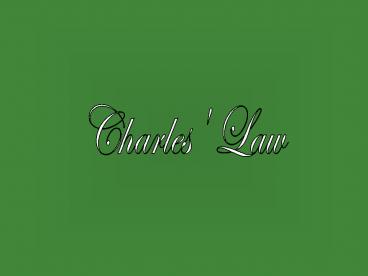Charles' Law - PowerPoint PPT Presentation
1 / 11
Title:
Charles' Law
Description:
Volume is directly proportional to Kelvin temperature ... Temperature must be in Kelvin. ... The initial calculated answer (T2) is in Kelvin (Tc = TK 273) ... – PowerPoint PPT presentation
Number of Views:40
Avg rating:3.0/5.0
Title: Charles' Law
1
Charles' Law
2
(1746-1823)
Jacques Charles
- The first person to fill a balloon with hydrogen,
he took many balloon flights. - Investigated the relationship between volume and
temperature in gases - Result Charles Law
3
Charles Law Stated
The volume of a definite quantity of gas is
directly proportional to its Kelvin temperature,
provided the pressure remains constant.
4
Charles Law Explained
- As the temperature of a gas increases, its volume
also increases, and vice versa
- Temperature must be measured in Kelvin
- Definite quantity constant number of moles
- Pressure must be constant
5
Charles Law The Mathematics
- V ? TK
Volume is directly proportional to Kelvin
temperature
- V kTK
Volume is equal to some constant, k, times TK
(the value of k depends only on pressure and
number of moles)
- V/TK k
Any volume divided by the corresponding
temperature (the volume-temperature ratio) is
equal to the constant k.
A straight line graph results from a direct
proportion.
The slope of the line is equal to k.
The working form of the equation is
V1/TK1 V2/TK2
Any volume-temperature ratio equals any other so
long as P and n are constant.
6
V1/TK1 V2/TK2 This is the working form of the
equation, used to predict changes in V or T for a
trapped gas, such as in a balloon, a scuba tank,
or an engine cylinder.
- V1 initial volume
- TK1 initial Kelvin temperature
- V2 final volume
- TK2 final Kelvin temperature
- Three of the four must be known (or knowable)
- Any consistent units for V are acceptable
- Temperature must be in Kelvin. It is the only
temperature unit with no negative values,
necessary to prevent calculating a negative
volume (which would be nonsensical).
- P and n must be constant.
- The identity of the gas is irrelevant (as in
Boyles Law).
7
Important Points
1. The identity of the gas is irrelevant, as it
is with Boyles Law. Continue to meditate on the
significance of this.
2. All volume vs. temperature plots are straight
lines which intersect (by extrapolation) at a
common point, the point at which volume equals
zero. For every gas, regardless of the values of
n and P, this point of intersection occurs at T
-275.15ºC 0 K, also known as absolute zero.
This has never been achieved, though scientists
have reached 0.0001 K.
8
Instructions for Example Problems
As you move through the example, make sure you
understand each step before proceeding. In each
case the first step is extracting the values from
the text of the problem. Next, units are made
compatible with appropriate conversions. Finally,
substitutions are made and the problems is
solved.
9
4.0 liters
Example 1 A balloon filled with helium has a
volume of 4.0 liters at a temperature of 20.0ºC.
It is submerged in liquid nitrogen at a
temperature of -196.0ºC. What would be its volume
at that temperature?
20.0ºC
-196.0ºC
What would be its volume?
1. V1 4.0 L
3. V2 ?
2. T1 20.0ºC
4. T2 -196.0ºC
293.0 K
77.0 K
Remember, temperatures must be expressed in
Kelvin units. (TK TC 273)
V1/T1 V2/T2
V2
(4.0 L)
Substituting into the equation
(293.0 K)
(77.0 K)
V2
(0.0137)
(77.0 K)
V2 1.05 L
(0.0137)(77.0 K) V2
The final answer (V2) is in liters since the
initial volume (V1) is in liters.
10
Example 1 A balloon filled with helium has a
volume of 4.0 liters at a temperature of 20.0ºC.
It is submerged in liquid nitrogen at a
temperature of -196.0ºC. What would be its volume
at that temperature?
1. V1 4.0 L
3. V2 ?
2. T1 20.0ºC
4. T2 -196.0ºC
293.0 K
77.0 K
Remember, temperatures must be expressed in
Kelvin units. (TK TC 273)
V1/T1 V2/T2
V2
(4.0 L)
(293.0 K)
(77.0 K)
V2
(0.0137)
(77.0 K)
V2 1.05 L
(0.0137)(77.0 K) V2
The final answer (V2) is in liters since the
initial volume (V1) is in liters.
11
12.0 L
Example 2 A certain balloon filled has a maximum
volume of 12.0 liters. It is filled with air to a
volume of 8.5 L at 25.0ºC? What is the maximum
temperature to which it could be heated without
bursting?
8.5 liters
25.0ºC
What is the maximum temperature?
1. V1 8.5.0 L
3. V2 12.0 L
2. T1 25.0ºC
4. T2 ?
298.0 K
Remember, temperatures must be expressed in
Kelvin units. (TK TC 273)
V1/T1 V2/T2
(12.0 L)
(8.5 L)
(298.0 K)
(T2)
(12.0 L)
(0.0285)
(T2)
(12.0 L)
421 K 148 ºC
T2
(0.0285)
The initial calculated answer (T2) is in Kelvin
(Tc TK 273).
12
Example 2 A certain balloon filled has a maximum
volume of 12.0 liters. It is filled with air to a
volume of 8.5 L at 25.0ºC? What is the maximum
temperature to which it could be heated without
bursting?
1. V1 8.5.0 L
3. V2 12.0 L
2. T1 25.0ºC
4. T2 ?
298.0 K
Remember, temperatures must be expressed in
Kelvin units. (TK TC 273)
V1/T1 V2/T2
(12.0 L)
(8.5 L)
(298.0 K)
(T2)
(12.0 L)
(0.0285)
(T2)
(12.0 L)
421 K 148 ºC
T2
(0.0285)
The initial calculated answer (T2) is in Kelvin
(Tc TK 273).
13
For homework, print out and complete Charles
Law Worksheet Practice Problems for this
section Repeat This Lesson Go to the Next
Lesson Return to Gas Lessons Menu Return to
Main Page































